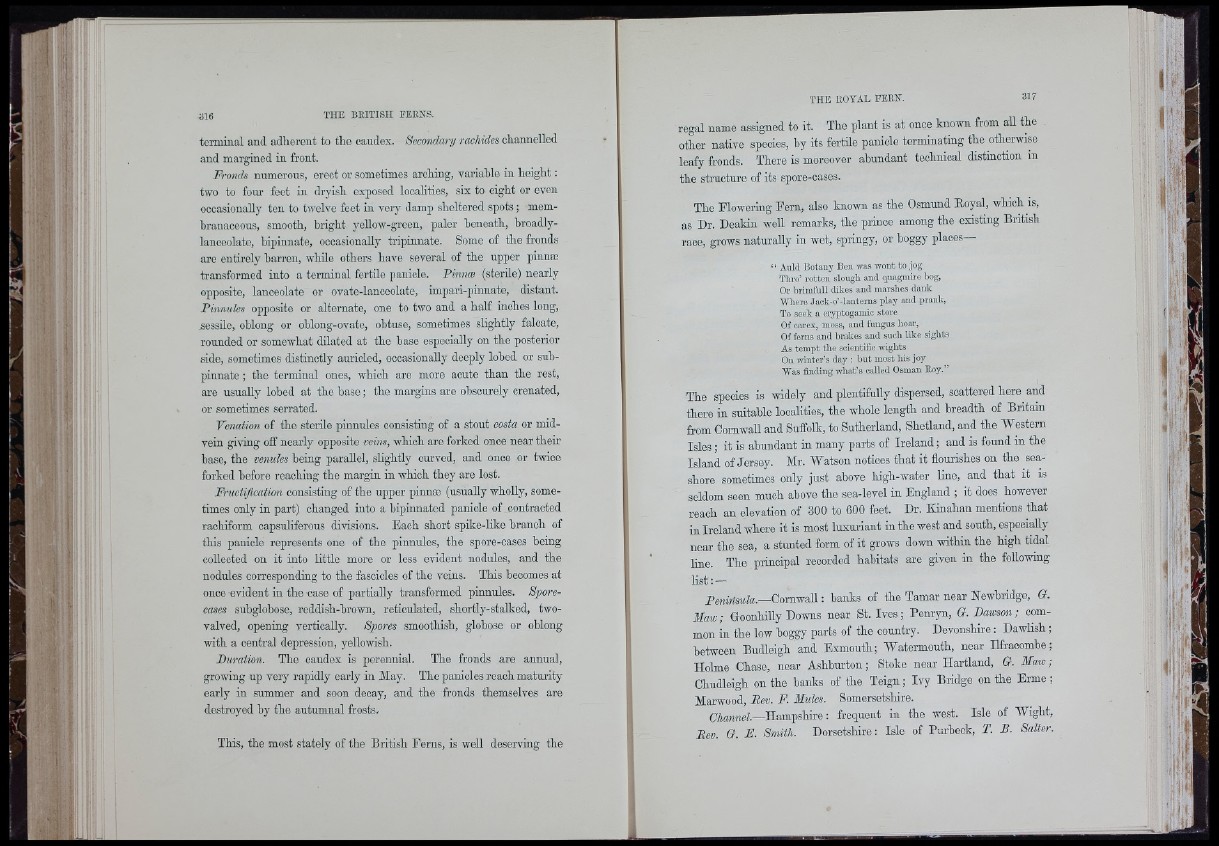
3 1 6 THE BKITISH EEENS.
terminal and adherent to the caudex. Secondary rachides channelled
and margined in front.
Fronds numerous, erect or sometimes arching, variable in height :
two to four feet in dryish exposed localities, six to eight or even
occasionally ten to twelve foet in very damp sheltered spots ; membranaceous,
smooth, bright yellow-green, paler beneath, broadly-
lancoolato, bipinnate, oooasionally tripinnate. Some of the fronds
are entirely barren, while others have several of the upper pinnæ
transformed into a terminal fertile panicle. Pinnæ (sterUe) nearly
opposite, lanceolate or ovate-lanoeolate, impari-pinnate, distant.
Pinnules opposite or alternate, one to two and a half inches long,
sessile, ohlong or oblong-ovate, obtuse, sometimes slightly falcate,
rounded or somewhat dilated at the base especially on the posterior
side, sometimes distinctly auricled, oceasionaUy deeply lobed or sub-
pinnate ; the terminal ones, which aro more acute than the rest,
are usually lohed at the base ; the margins are obscurely crenated,
or sometimes serrated.
Venation of the sterile pinnules consisting of a stout costa or midvein
giving off nearly opposite t'cins, which are forked once near their
base, the venules being parallel, slightly curved, and onoe or twice
forked before reaching the margin in which they are lost.
Fructification consisting of the upper pinnæ (usually wholly, sometimes
only in part) changed into a hipinnated panicle of contracted
rachiform oapsuliferous divisions. Each short spike-like branch of
this panicle represents one of the pinnules, the spore-oases being
collected on it into little more or less evident nodules, and the
nodules corresponding to tho fascicles of the veins. This becomes at
onoe evident in the case of partially transformed pinnules. Spore-
cases suhglobose, reddish-brown, reticulated, shortly-stalked, two-
valved, opening vertically. SjJores smoothish, globose or oblong
with a central depression, yellowish.
Duration. The caudex is perennial. The fronds are annual,
growing up very rapidly early in May. The panicles reach maturity
early in summer and soon decay, and the fronds themselves are
destroyed by the autumnal frosts.
This, the most stately of the British Ferns, is well deserving the
regal name assigned to it. The plant is at onoe known from all the
other native species, hy its fertile panicle terminating the otherwise
leafy fronds. There is moreover abundant technical distinction in
the structure of its spore-cases.
The Flowering Fern, also known as the Osmund Eoyal, which is,
as Dr. Deakin weU remarks, the prince among the existing British
race, grows naturally in wet, springy, or boggy places—
“ Auld Botany Ben was wfont to jog
Thro’ ro tten slongh and quagmire hog,
Or hrimfull dikes and marshes dank
■VVliere Jack-o’-lanterns play and praidc,
To seek a cryptogamic store
Of carex, moss, and fungus hoar.
Of ferns and brakes and such like sights
As tem p t th e scientific wights
On winter’s day : h u t most his joy
"Was finding what’s called Osman Eoy.”
The species is widely and plentifully dispersed, scattered here and
there in suitable localities, the whole length and breadth of Britain
from Cornwall and Suffolk, to Sutherland, Shetland, and the Western
Isles; it is abundant in many parts of Ireland; and is found in the
Island of Jersey. Mr. Watson notices that it flourishes on the seashore
sometimes only just above high-water hne, aud that it is
seldom seen much above the sea-levol in England ; it does however
reach an elevation of 300 to 600 feet. Dr. Kinahan mentions that
in Ireland where it is most luxuriant in the west and south, especiaUy
near the sea, a stunted form of it grows down within the high tidal
line. The principal recorded habitats are given in the following
list; —
PemVisafe.-Cornwall: hanks of the Tamar near Newbridge, G.
Maw; Goonhilly Downs near St. Ives; Penryn, G. Dawson; common
in the low boggy parts of the country. Devonshire: Dawlish;
between Budleigh and Exmouth; Watermouth, near Ilfraoomhe;
Holme Chase, near Ashburton; Stoke uear Hartlaud, G. Maw;
Chudleigh on the banks of the Teign; Ivy Bridge on the Erme ;
Marwood, Rev. F. Mules. Somersetshire.
Hampshire: frequent in the west. Isle of Wight,
Rev. G. F. Smith. Dorsetshire: Isle of Purbeck, T. B. Salter.
IlM.
i t ' ’
'J:.-
■ihi
iS
i î ‘1
k !i
\i
I )
Si
'III